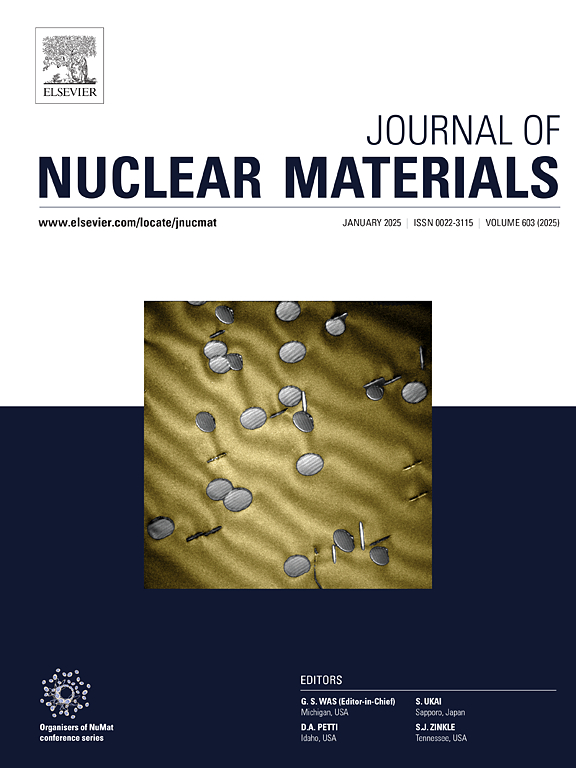α -和β-U3O8在稀双氧水溶液中的再水化动力学
IF 3.2
2区 工程技术
Q3 MATERIALS SCIENCE, MULTIDISCIPLINARY
引用次数: 0
摘要
铀矿精矿和乏燃料在氧化条件下蚀变相的形成是了解放射性核素在环境中的潜在迁移性和设计材料最佳储存条件的关键。然而,α -和β-U3O8在氧化条件下蚀变相随时间的分布还有待探索。在这里,α -和β-U3O8结晶粉末被浸泡在双氧水(1.6 × 10−1至5.4 × 10−5 M)的水溶液中,去除等分的溶液和固体,在1、8、15、22、29、36、46、58、71和83天进行分析。根据从固体中收集的拉曼光谱的偏最小二乘回归(PLSR)确定,无论U3O8的多晶型或溶液中H2O2的初始浓度如何,在一周内,U3O8都会在一天内显著改变为铀酰过氧化亚散[(UO2)(O2)(H2O)2],并被studtite [(UO2)(O2)(H2O)2]·2H2O所取代。提出了U3O8转变为亚晶和随后U3O8和亚晶转变为研究石的溶解/再沉淀机制。随着时间的推移,U3O8的两种多态性表现出相似的变化速率和程度。亚介石向研究石的再水合作用以前没有报道过,这表明需要进一步的工作来确定亚介石转化为研究石的机制以及哪些其他条件促进了这种再水合作用。本文章由计算机程序翻译,如有差异,请以英文原文为准。
Rehydration of metastudtite in the alteration kinetics of α– and β–U3O8 in dilute aqueous solutions of hydrogen peroxide
The formation of alteration phases on uranium ore concentrates and used nuclear fuels under oxidizing conditions is key to understanding the potential mobility of radionuclides in the environment and designing optimal storage conditions of materials. However, the time-dependent distribution of alteration phases on α– and β–U3O8 under oxidizing conditions has yet to be explored. Here, crystalline powders of α– and β–U3O8 were submerged in aqueous solutions of hydrogen peroxide (1.6 × 10−1 to 5.4 × 10−5 M) with aliquots of solution and solid removed for analysis at 1, 8, 15, 22, 29, 36, 46, 58, 71, and 83 days. Within one day there is significant alteration of U3O8 to the uranyl peroxide metastudtite, [(UO2)(O2)(H2O)2], that is replaced by studtite, [(UO2)(O2)(H2O)2]·2H2O, within a week regardless of the polymorph of U3O8 or the initial concentration of H2O2 in solution, as determined by partial least squares regression (PLSR) of Raman spectra collected from the solids. A dissolution/reprecipitation mechanism is proposed for both the alteration of U3O8 to metastudtite and the subsequent alteration of both U3O8 and metastudtite to studtite. The two polymorphs of U3O8 exhibit similar rates and extents of alteration over time. The rehydration of metastudtite to studtite has not been previously reported and highlights the need for future work to determine the mechanism by which metastudtite is converted to studtite and what other conditions facilitate this rehydration.
求助全文
通过发布文献求助,成功后即可免费获取论文全文。
去求助
来源期刊

Journal of Nuclear Materials
工程技术-材料科学:综合
CiteScore
5.70
自引率
25.80%
发文量
601
审稿时长
63 days
期刊介绍:
The Journal of Nuclear Materials publishes high quality papers in materials research for nuclear applications, primarily fission reactors, fusion reactors, and similar environments including radiation areas of charged particle accelerators. Both original research and critical review papers covering experimental, theoretical, and computational aspects of either fundamental or applied nature are welcome.
The breadth of the field is such that a wide range of processes and properties in the field of materials science and engineering is of interest to the readership, spanning atom-scale processes, microstructures, thermodynamics, mechanical properties, physical properties, and corrosion, for example.
Topics covered by JNM
Fission reactor materials, including fuels, cladding, core structures, pressure vessels, coolant interactions with materials, moderator and control components, fission product behavior.
Materials aspects of the entire fuel cycle.
Materials aspects of the actinides and their compounds.
Performance of nuclear waste materials; materials aspects of the immobilization of wastes.
Fusion reactor materials, including first walls, blankets, insulators and magnets.
Neutron and charged particle radiation effects in materials, including defects, transmutations, microstructures, phase changes and macroscopic properties.
Interaction of plasmas, ion beams, electron beams and electromagnetic radiation with materials relevant to nuclear systems.
 求助内容:
求助内容: 应助结果提醒方式:
应助结果提醒方式:


